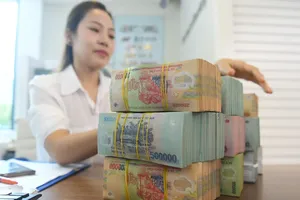Over the past six months, the banking sector has injected an additional VND1.6 quadrillion into the economy, underscoring its critical role in bolstering production and business activities. This robust credit growth is significantly driving overall economic expansion.
Accelerating capital injection

Vietnam's credit growth has surged to a multi-year high, with the total outstanding credit balance reaching over VND17.2 trillion (US$657.83 million) as of June 30, according to Deputy Governor of the State Bank of Vietnam (SBV) Pham Thanh Ha. This marks a 9.9 percent increase from the end of 2024 and a 19.32 percent rise compared to the same period last year.
The robust growth reflects strong capital allocation toward key production sectors including wholesale and retail, agriculture and rural development, processing and manufacturing and high-tech enterprises, driving economic momentum.
The steady increase in credit in these areas shows the effectiveness of flexible monetary management policies, aiming at sustainable growth. With outstanding loans at the end of 2024 at VND15.6 quadrillion, it is estimated that the banking system has injected about VND1.6 quadrillion into the economy in the past 6 months.
Many commercial banks have shown strong growth and focused on industries supporting the economy. Chairman of the Board of Directors of VietinBank Tran Minh Binh said that the bank's credit in the first 6 months of 2025 increased by 10 percent compared to the beginning of the year, reaching more than VND1.9 quadrillion. Capital flows were allocated to key economic projects, especially infrastructure projects.
According to Chairman Nguyen Thanh Tung of Vietcombank's Board of Directors, the bank's outstanding credit reached VND1.6 quadrillion in the first half of the year, reflecting an increase of 11.1 percent compared to the end of 2024. In addition to providing independent financing and serving as a central point for credit arrangements for numerous significant projects, Vietcombank has concentrated on extending credit to the production sector and priority industries.
Additionally, the bank is actively promoting green credit, exports, and FDI customers.
As for Agribank, the outstanding credit as of June 30 surpassed VND1.85 quadrillion, marking a 7.6 percent increase since the start of the year, which is higher than the same period in 2024. Notably, outstanding loans directed towards agriculture and rural areas amounted to over VND1.13 quadrillion, representing more than 61 percent of the total outstanding loans.
Credit flow reaches all economic segments, fueling growth
According to Nguyen Phi Lan, Director of the Department of Forecasting Statistics - Monetary and Financial Stability under the State Bank of Vietnam (SBV), over 100 credit institutions are currently generating outstanding debt ratios for the private economic sector. This, along with approximately 209,000 small and medium enterprises with outstanding debt at credit institutions, confirms that credit flows have widely permeated all segments of the economy.
Results from the SBV's business trend survey for the third quarter of 2025 indicate that commercial banks have increased their credit growth expectations for 2025 to 16.8 percent. This figure is higher than the actual rate observed in 2024 and surpasses the SBV's target of 16 percent for 2025. Economic experts note that with Vietnam targeting a Gross Domestic Product (GDP) growth of at least 8 percent in 2025, credit is widely anticipated to remain a crucial driver for growth.
MBS Securities Company forecasts that credit growth in 2025 will fall within the range of 17 percent to 18 percent. This projected growth is expected to be propelled by a robust recovery in the manufacturing industry, strong domestic consumption, and an acceleration of public investment disbursement. The research division of SSI Securities Company also commented that, given the current uncertainties in the global market related to tax policies, the impetus for credit growth in the latter half of the year may originate from projects linked to real estate and infrastructure.
Assoc. Prof. Nguyen Huu Huan from Ho Chi Minh City University of Economics remarked that credit in the first half of 2025 has shown significant growth, yet there remains considerable potential for further increase. With a credit growth target set at 16 percent, which is equivalent to approximately VND2.5-VND3 quadrillion, there is currently around VND1.4 quadrillion available to be injected into the economy from now until the year's end. This amount is sufficient to bolster GDP growth at 8 percent while keeping inflation under 4.5 percent.
Governor of the State Bank of Vietnam Nguyen Thi Hong has directed the diversification of funding sources to avoid reliance on credit capital.
To achieve a GDP growth target of over 8 percent this year, the State Bank of Vietnam has set a credit growth target of approximately 16 percent, but this will be adjusted flexibly based on actual conditions. Monetary policy will also be managed appropriately to control inflation, stabilize the market, and ensure the safety of the banking system - a crucial factor in supporting business development.
However, high economic growth must rely on both domestic and foreign capital, rather than being overly dependent on bank credit. With the credit-to-GDP ratio reaching 134 percent by the end of 2024, any further increase could pose risks to the system and affect the sustainability of growth. This is an issue that the Ministry of Finance and relevant agencies need to pay special attention to in the near future.
In addition, Dr. Nguyen Tri Hieu advised that careful consideration should be given to capital allocation. Alongside prioritizing infrastructure, technology, and small to medium enterprises, it is important to evaluate the potential of investing in stocks, gold, and real estate, as these could lead to asset bubbles and financial risks.









)

)












